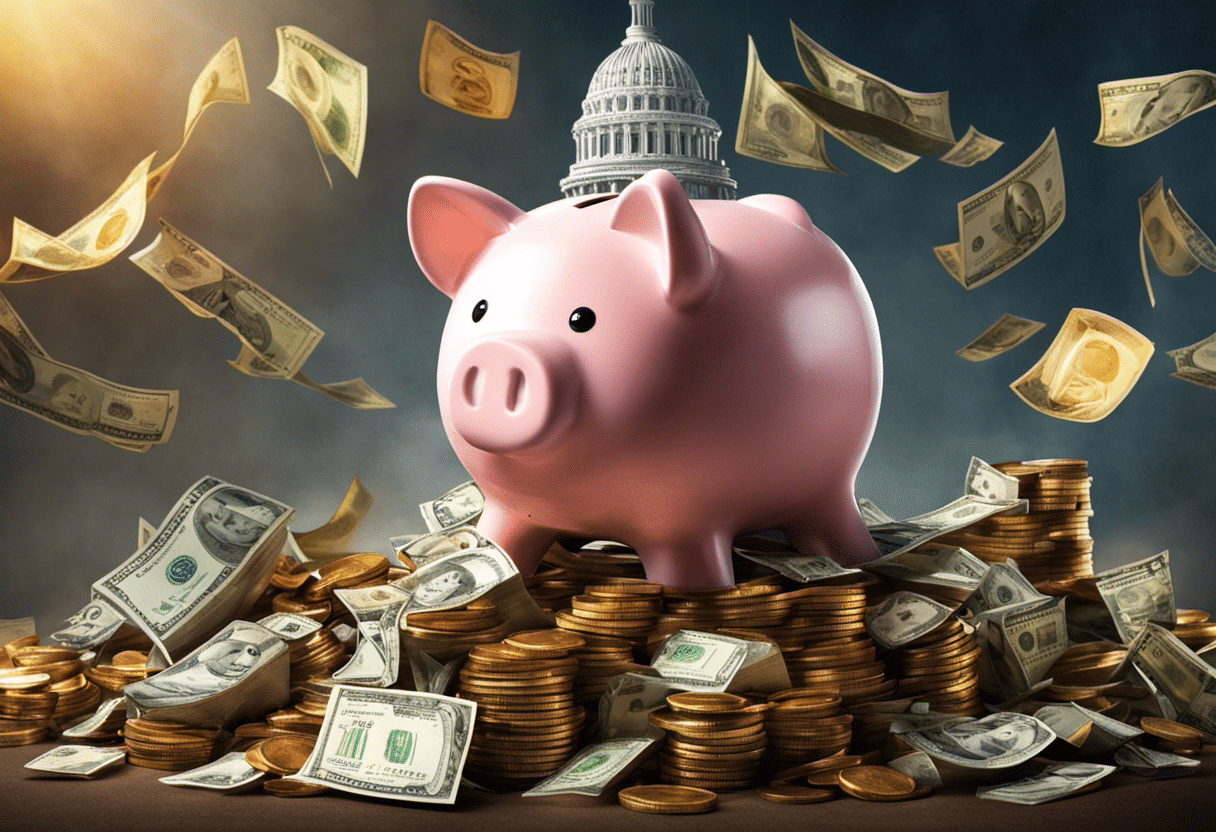Are you tired of living paycheck to paycheck, constantly worrying about unexpected expenses?
Well, here’s a surprising fact for you: only 40% of Americans have enough savings to cover a $1,000 emergency.
But don’t fret! In this article, we’ll show you how to build an emergency fund from scratch.
With some simple steps and a little discipline, you can be prepared for any financial curveball that comes your way.
So let’s get started on your journey to financial security!
Key Takeaways
- Set clear and achievable financial goals using the SMART method
- Evaluate income versus expenses to determine savings potential
- Identify areas to cut back on expenses without sacrificing too much
- Allocate funds towards building an emergency fund to ensure financial stability
Setting Financial Goals

You should start by setting clear and achievable financial goals.
Imagine this: You’re standing on the edge of a beautiful beach, with the waves crashing against the shore. The sun is shining brightly overhead, warming your skin. As you take a deep breath, you feel a sense of calm and clarity wash over you. This is how it feels to have financial goals in place.
Setting financial goals is like mapping out your journey towards financial success. It’s about knowing where you want to go and how you plan to get there. Your goals should be specific, measurable, attainable, relevant, and time-bound (SMART). For example, instead of saying ‘I want to save money,’ a SMART goal would be ‘I will save $500 per month for the next six months.’
By setting clear and achievable financial goals, you give yourself direction and purpose. It becomes easier to make decisions that align with your objectives. With each step you take towards your goals, you’ll gain confidence in your ability to manage your finances effectively.
Now that you have set your financial goals firmly in place, it’s time to assess your current financial situation…
Assessing Your Current Financial Situation
So, you’ve set your financial goals and now it’s time to assess where you currently stand.
Let’s dive into the nitty-gritty of your income versus expenses and figure out your savings potential.
Are you ready to take a closer look at how much money is coming in, how much is going out, and how much you can actually save?
It’s time to get real about your financial situation!
Income Vs. Expenses
When it comes to building an emergency fund, it’s important to compare your income and expenses. This will help you determine how much you can save each month and how quickly you can reach your savings goal. To make this process easier, let’s break down your income and expenses into a table:
| Income | Expenses |
|---|---|
| $3,000 | $2,500 |
| Rent | |
| Utilities | |
| Groceries | |
| Transportation |
In this example, you have a monthly income of $3,000 and monthly expenses of $2,500. This means you have a surplus of $500 that can be allocated towards building your emergency fund. By understanding your income versus expenses, you can identify areas where you can cut back in order to increase your savings potential without sacrificing too much.
Now let’s explore ways to maximize your savings potential without drastically changing your lifestyle.
Savings Potential
To maximize your savings potential, it’s important to identify areas where you can cut back on expenses without drastically changing your lifestyle. Here are four simple ways to start saving money today:
- Trim the excess: Take a close look at your monthly bills and subscriptions. Do you really need that gym membership you never use or those streaming services you hardly watch? Cancel what you don’t need and save the extra cash.
- Cook at home: Eating out can be convenient, but it’s also expensive. Try cooking meals at home instead of dining out regularly. Not only will you save money, but you’ll also have control over the ingredients and portion sizes.
- Shop smarter: Before making a purchase, compare prices online or in different stores to find the best deal. Consider buying generic brands instead of name brands for everyday items – they often work just as well.
- Cut energy costs: Unplug electronics when not in use, adjust your thermostat slightly, and switch to energy-efficient light bulbs – these small changes can significantly reduce your utility bills.
By implementing these strategies, you’ll be able to free up funds for saving without sacrificing too much of your current lifestyle.
Now that you’ve identified areas where you can cut back on expenses, let’s move on to creating a budget to save even more effectively…
Creating a Budget to Save

You can start creating a budget by tracking your expenses and identifying areas where you can cut back. Imagine you’re on a treasure hunt, searching for hidden coins in the nooks and crannies of your spending.
Start by gathering all your receipts, bills, and statements. Take a deep breath, put on your detective hat, and dive into the world of numbers.
As you pore over each expense, let your imagination run wild. Picture yourself as a money-saving superhero, swooping in to rescue those extra dollars from unnecessary purchases. Look for patterns and trends in your spending habits; they hold clues to where you can make cuts without sacrificing too much joy.
Maybe it’s that daily latte or those impulsive online shopping sprees that are draining your resources. Or perhaps eating out at fancy restaurants has become a habit rather than an occasional treat. Whatever it is, identify those areas where you can tighten the purse strings without feeling deprived.
With this newfound understanding of your spending habits, you’ll be ready to tackle the next section: identifying and cutting expenses like a pro! But first, take a moment to celebrate how close you are to building that emergency fund – one step at a time!
Identifying and Cutting Expenses

Hey there!
Let’s dive into the next topic: Identifying and Cutting Expenses.
Now, this is where you get to be a detective and analyze your monthly spending habits. By doing so, you’ll uncover those sneaky non-essential costs that are draining your wallet.
But fear not, because armed with smart budgeting strategies, you’ll learn how to trim those unnecessary expenses and take control of your financial future.
Analyzing Monthly Spending
Once you’ve gathered all your receipts and bills, it’s time to start analyzing your monthly spending.
Think of this process as unraveling a mystery – one that holds the key to building your emergency fund.
Dive into the numbers like Sherlock Holmes on a case, examining each expense with a keen eye. Look for patterns, outliers, and areas where you can make adjustments.
Maybe you discover that your daily coffee runs are draining your wallet faster than you thought. Or perhaps those subscription services are adding up more than you realized.
By scrutinizing your spending habits, you’ll uncover hidden treasures of savings waiting to be claimed.
Now armed with this knowledge, it’s time to move onto the next phase: trimming non-essential costs without sacrificing enjoyment or quality of life.
Trimming Non-Essential Costs
To start trimming non-essential costs, take a close look at your monthly expenses and identify areas where you can make adjustments. It’s time to unleash your inner detective and find those hidden money pits.
Start with your entertainment expenses – do you really need all those streaming subscriptions? Maybe it’s time to cut back on eating out or find cheaper alternatives for your daily coffee fix. Remember, every dollar counts when it comes to building an emergency fund from scratch.
By making small changes in these areas, you’ll be well on your way to saving more and spending less.
Now that you’ve trimmed the fat, let’s move on to some smart budgeting strategies that will help maximize your savings potential.
Smart Budgeting Strategies
Now that you’ve identified areas where you can trim non-essential costs, it’s time to explore some smart budgeting strategies that will help you make the most of your savings. Here are a few tips to get you started:
- Track your expenses: Keep a record of every penny you spend. This will give you a clear picture of where your money is going and help you identify areas where you can cut back. Use budgeting apps or spreadsheets to make tracking easier. Categorize your expenses into different groups like housing, transportation, food, etc.
- Create a realistic budget: Set specific goals for saving and allocate your income accordingly. Be sure to include both fixed and variable expenses in your budget plan. Prioritize essential expenses like rent/mortgage payments and utilities. Allocate a portion of your income towards building an emergency fund.
Generating Additional Income

If you’re looking to generate additional income for your emergency fund, consider taking on a side gig or freelance work. Imagine the possibilities of turning your hobbies and skills into a money-making venture. Whether it’s photography, writing, graphic design, or even pet-sitting, there are countless opportunities out there waiting for you to seize them.
Embrace your creative side and think outside the box. Offer your services on platforms like Fiverr or Upwork, where individuals from all over the world are seeking talented freelancers like yourself. Start small and gradually build up your client base as word spreads about your exceptional work.
Don’t limit yourself to traditional methods either; explore unconventional avenues that align with your passions. Teach an online course about something you excel at or monetize your blog through sponsored content and affiliate marketing.
By diversifying your income streams through these part-time gigs or freelance work, you can not only accelerate the growth of your emergency fund but also gain valuable experience and expand your professional network.
So now that you’ve got some extra money coming in, let’s move on to maximizing savings and building that robust emergency fund even further…
Maximizing Savings and Building Your Emergency Fund

Start by examining your monthly expenses and identifying areas where you can make small changes to save more money. Saving money is crucial when it comes to building an emergency fund from scratch.
Here are some creative ways to maximize your savings and reach your financial goals.
- Cutting unnecessary expenses: Take a close look at your subscriptions, memberships, and daily habits. Are there any services or products that you could live without? Canceling that unused gym membership or reducing the number of streaming services can significantly free up extra cash each month.
- Meal planning: Plan out your meals for the week and create a shopping list based on those meals. This will not only help you avoid unnecessary trips to the grocery store but also prevent impulse purchases. Consider using coupons or buying generic brands to save even more.
- Automate savings: Set up automatic transfers from your checking account to a separate savings account dedicated solely to your emergency fund. By automating this process, you won’t have to rely on willpower alone, making it easier for you to consistently save.
By implementing these strategies, you’ll be able to stretch every dollar further and accelerate the growth of your emergency fund.
Frequently Asked Questions
What Are Some Common Mistakes People Make When Setting Financial Goals?
You’re eager to set financial goals, but watch out for common mistakes. Remember, it’s crucial to avoid overspending, neglecting savings, and not having a clear plan. Keep these in mind to achieve your desired financial success.
How Can I Determine My Current Financial Situation if I Have Multiple Sources of Income?
To determine your current financial situation with multiple sources of income, start by tracking all your earnings. Then calculate your total income and expenses to see how much you can save for an emergency fund.
Are There Any Strategies to Help Me Stick to My Budget and Avoid Overspending?
Stick to your budget and avoid overspending by creating a visual reminder, like a jar filled with marbles representing each dollar. As you spend, remove marbles to see the impact on your emergency fund.
What Are Some Less Obvious Expenses That People Often Overlook When Trying to Cut Expenses?
When trying to cut expenses, people often forget about smaller costs that add up over time. These can include subscriptions, eating out, and impulse purchases. Being aware of these hidden expenses can help you save more in the long run.
Are There Any Potential Risks or Downsides to Generating Additional Income Through Side Hustles or Part-Time Jobs?
“Building your emergency fund is important, but it’s crucial to consider the potential risks of taking on side hustles or part-time jobs. Balancing income and time can be challenging, so weigh the downsides carefully.”
Conclusion
Congratulations on taking the first steps towards building your emergency fund from scratch! By setting financial goals, assessing your current situation, and creating a budget, you are well on your way to financial security.
Remember to identify and cut expenses where possible and consider generating additional income to maximize savings.
Did you know that according to a recent survey, 60% of Americans do not have enough money saved for unexpected expenses? Don’t be part of that statistic – start building your emergency fund today!

